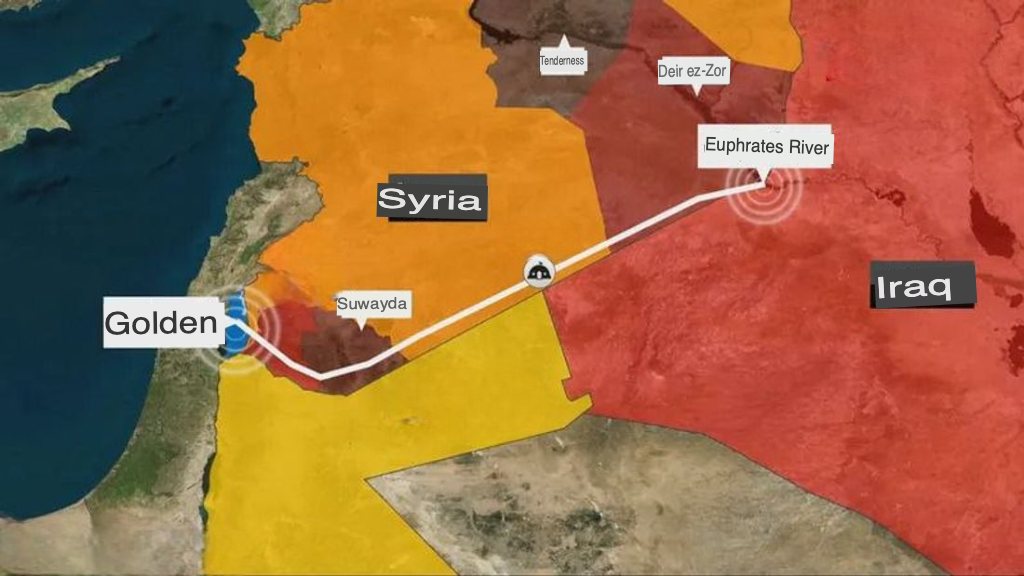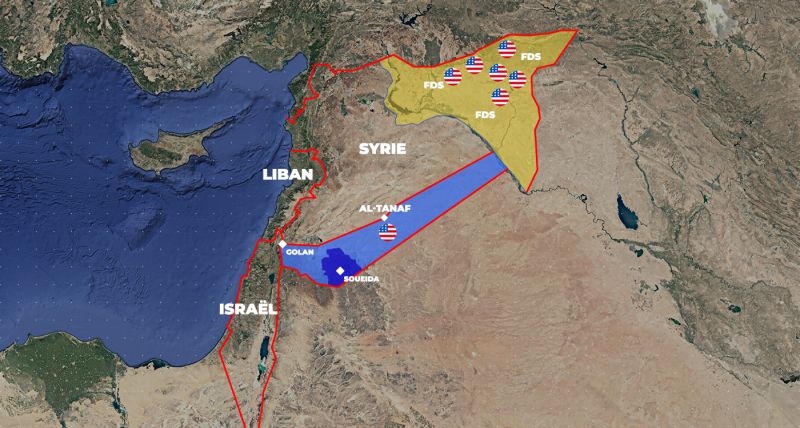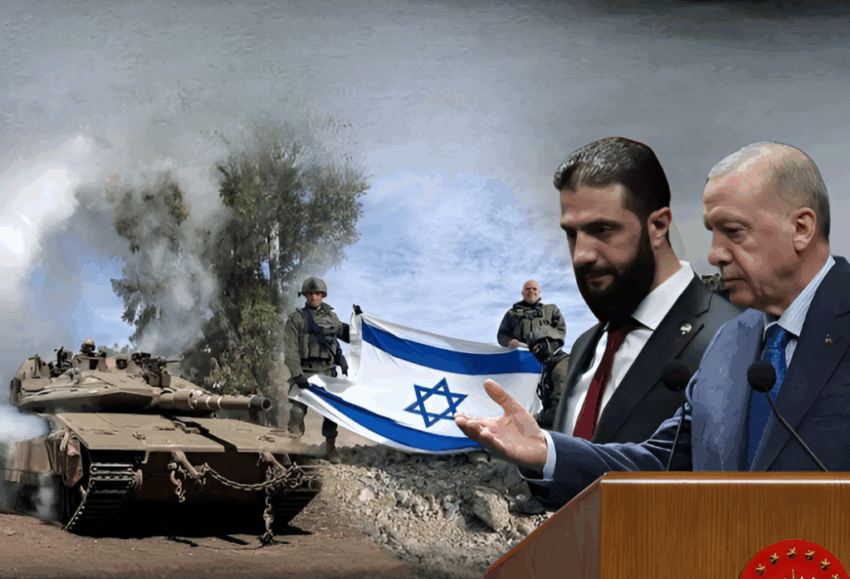The historical Zionist expansion strategy, referred to as David’s Corridor, is a land pathway that extends from the Golan Heights to northern Syria. Reportedly, this initiative is aimed at the political and geographical fragmentation of the area, a process that Israel and the Syrian Democratic Forces (SDF), led by the US-backed Kurdish militant group known as the People’s Defense Units (YPG), started after the collapse of al-Assad’s regime. The route starts in the Golan Heights, which Israel seized from Syria during the 1967 Six-Day War and subsequently annexed in 1981. It then traverses through towns in eastern and northern Syria, ultimately reaching Iraq. Today, we will seek to answer the question: What is the true purpose of this corridor?

Initially, the corridor was designed for Israel to achieve four objectives:
1.Firstly, to create a land link connecting Israel, Syria, and Iraq;
2. Secondly, to fulfil the alleged biblical prophecy and the myths tied to the so-called “Promised Land” by reaching out to the Euphrates River;
3. Thirdly, to develop a Kurdish state or an autonomous area in Syria that merges with Iraqi Kurdistan; and
4. Lastly, to set up a route for “Israel” to provide arms to Kurdish groups, especially the PKK (Kurdistan Workers’ Party).
Earlier, in March, the PKK announced it was laying down its arms and disbanding, meaning Israel’s fourth goal became irrelevant. Nonetheless, according to Turkey, there exists a fifth and unacknowledged goal, which is the transportation of Syrian oil via this route from ports located in the occupied regions, including the Kurdish regions in Syria and occupied Iraq, which offers the possibility of transporting oil without passing through Syrian territory. According to writer and political analyst, Mohammed Hawaidi, the “David corridor” is also a project the Americans worked on in 2023, calling it “the Sunni Tribal Belt Project” in Eastern Syria (first proposed in 2020), which at a time was considered as the basis for forming a connecting belt zone with Syria most southern region whilst severing the land corridor between Tehran and Beirut. This route stretches from the eastern bank of the Euphrates to the western side, traversing Area 51 and the Al-Tanf base, ultimately reaching southern Syria and linking with the Golan Heights. This development signifies the closure of the Al-Bukamal crossing and subsequent alterations. Yet, here we are again, with the topic of the “David’s Corridor” back on the agenda, whilst a ban on Turkish military bases in Syria remains intact. The question is, for how long?
DOCUMENT: The Sunni Tribal Belt Project (Source: Candle Grup)
The-Sunni-Tribal-Belt-Project-in-Eastern-Syria-2
The report concluded that “the ‘Sunni Tribal Belt Project’ could serve as a basis for forming a belt zone in the most southern region of Syria (Daraa and Suwayda) with support from Jordan under the pretext of combating drug trafficking.” Interestingly, the recent conflicts involving Syria’s interim President, Ahmed al-Sharaa and Israel originated from the Suwayda (Sweida) Governorate, where the pretence of fighting drug trafficking seems to have been abandoned, to be supplanted by an Israeli narrative focused on the so-called protection of the Druze.
Today, for Israel, the “David’s Corridor” primarily serves four purposes:
-
To speed up the balkanisation of Syria, before Turkey decides to put military bases in the country
-
To infiltrate the Shiite religious and political strongholds located in Najaf and Karbala, which act as pivotal centres of opposition against Israeli and Western influence in Iraq.
-
To act as a strategic barrier to prevent the reconstitution of the resistance axis
-
A foothold for the Greater Israel Project
In a recent post on X, analyst Ibrahim Majed reveals the “Hidden Axis Behind Israel’s Expansion into Syria and Iraq.”
David’s Corridor: The Hidden Axis Behind Israel’s Expansion into Syria and Iraq
A new geopolitical corridor is quietly forming in the shadows of the Levant, connecting the occupied Golan Heights to southeastern Syria and extending toward the Iraqi border.
Known as David’s… pic.twitter.com/jo7uvCWIYd— Ibrahim Majed (@ibrahimtmajed) July 17, 2025
Israel has carried out multiple airstrikes against government forces and convoys near Suwayda, including a strike on the Syrian Defense Ministry headquarters that killed three and injured 34, according to Syrian officials. This Israeli attack on Damascus occurred after a ceasefire announcement by the Interim Syrian government and Druze leaders. The power vacuum in Suwayda highlights Al-Sharra’s limited control and raises fears of further fragmentation without a sustainable political agreement. The subsequent withdrawal of Syrian forces signifies the shortcomings of imposed centralisation and Jolani’s inability to preserve the integrity of Syrian borders. The lack of a solid response to this brutal attack would raise further questions about Jolani’s loyalty, which increasingly appears to align with Israeli interests, as each day goes by.
Although it may be too early to discuss a conflict between Israel and Turkey through their respective proxy on the ground, it is essential to acknowledge the fundamentally divergent perspectives of these two nations regarding Syria. ICI Beyrouth has the story…

IMAGE: The David’s Corridor, from the occupied Syrian Golan Heights in the southwest, passing through southern Syrian provinces such as Quneitra, Daraa, and As-Suwayda, then heading east through the Syrian Badia to reach the strategic Al-Tanf crossing on the Syrian-Iraqi-Jordanian border, and ending at the Al-Bukamal crossing on the Euphrates River (Source: Sky News)
Elie-Joe Kamel reports for ICI Beyrouth…
Partition of Syria, “David’s Corridor”… What is it really?
(Translated from French to English using DeepL)
Since the fall of Bashar al-Assad’s regime, Israel has stepped up its manoeuvres in Syria in a possible attempt to assert itself as the master of the game against Turkey, which is trying to fill the vacuum left by Iran’s eclipse. Israel continues to carry out strikes against military positions of the former regime and pro-Iranian militias, is advancing and establishing a near-permanent presence in the Golan Heights and Mount Hermon, not to mention recent statements by Israeli leaders in favor of partitioning Syria into autonomous entities.
One topic in particular is surfacing, particularly in the Arab press and among Turkish leaders: the “David Corridor,” through which the Jewish state is attempting to connect southern Syria near the Golan Heights to northeastern Syria. A land passage? A logistics corridor? A buffer zone? What is it really?
It is worth recalling that Israeli Prime Minister Benjamin Netanyahu has stated that he will not allow the Syrian army to operate south of Damascus, demanding the “complete demilitarisation of southern Syria, including the provinces of Quneitra, Daraa and Sweida,” where, among other things, a large Druze community is concentrated.
Warning against any harm to the Druze in Syria, Israeli Defense Minister Israel Katz had threatened military intervention if necessary. Deadly clashes between armed Druze elements and government-affiliated forces took place last week in southern Syria. The recently formed Sweida Military Council in Syria had advocated for a decentralised secular state. Moreover, a fighter from the Military Council declared his allegiance to Israel in a video.
For his part, Israeli Foreign Minister Gideon Saar called the new Syrian government “Islamic terrorists,” accusing it of harming the Kurds and of speaking of “revenge” against the Alawites, the minority community from which the Assad family hails. “A stable Syria can only be a federal Syria that includes different autonomies and respects different ways of life,” Saar said.
Interviewed by Ici Beyrouth, David Rigoulet-Roze, a Middle East researcher associated with Iris, believes that Israel “is virtually seeking to establish a sort of corridor connecting the Golan Heights via the Syrian Druze region of Sweida to the American base of Al-Tanf along the border between Syria and Iraq and likely to extend towards the region controlled by the SDF (Syrian Democratic Forces), which is predominantly Kurdish.”
It would therefore be a sort of “southern buffer zone with a mirror effect of that established by the Turks in northern Syria,” according to Mr. Rigoulet-Roze, for whom this “supposed corridor is part of the Israeli desire to secure its territory in the east by protecting control of a strategic axis rather than a real logic of territorial expansion strictly speaking.” He emphasises that “the primary objective is to prevent the potential reconstitution of an axis for the transfer of Iranian flows to Hezbollah in Lebanon or even to the West Bank.”

Partition of Syria
Contacted by Ici Beyrouth, Riad Kahwaji, a Dubai-based Middle East security and defense analyst and director of the Institute for Middle East and Gulf Military Analysis (Inegma), believes that Israel “wants to see a weak or puppet Syrian government and prefers to be surrounded by autonomous religious entities to justify its own existence as a religious state.” “The Israelis are trying to take advantage of the current situation in Syria to seize new territories under the pretext of creating security zones that they will need for their future negotiations,” according to Kahwaji. He emphasises, however, that “this project does not necessarily align with the American strategy, which instead prioritises the expansion of the Abraham Accords,” of normalisation with Tel Aviv.
The Jewish state “is reportedly trying to create a buffer zone in southern Syria, composed mainly of Druze, who would, in a way, join those (Druze) in Israel who are loyal to the Jewish state,” Kahwaji said. “It remains to be seen whether the creation of this buffer zone is unanimously accepted among the Druze in Syria.” He added: “It is a little early to predict how things will evolve.”
Israeli-Turkish proxy conflict?
In this vein, it is legitimate to question the relationship between Israel and Turkey, the two main players in Syria.
According to Mr. Kahwaji, the Israelis want to “prevent the Turks from filling the void left by the Iranian withdrawal.” He points out in this regard that the offensive by the Islamist group Hayat Tahrir al-Sham (HTC), which overthrew the regime, was launched at the initiative of, and with the training and funding of, Turkey. Turkey advocates for a unifying state and rejects any idea of Kurdish separatism. It should be noted that the Kurds have benefited from American support since 2014 as part of their coalition against the Islamic State in northeast Syria.
On January 6, Turkish President Recep Tayyip Erdogan warned against any partition of Syria. “We cannot allow Syria to be divided under any circumstances, and if we see the slightest risk, we will quickly take the necessary measures. […] We have the means,” Erdogan said.
The same story came from the interim Syrian President, Ahmad el-Chareh, who, during his official visit to Erdogan, mentioned “the threats that prevent the completion of territorial unity in the northeast of Syria,” advocating a “common strategy” with Ankara in the face of security threats.”
Let us recall that since 2016, and particularly after the fall of the regime, Turkey has been seeking to regain control of all the territory held by the SDF on its border, in an attempt to establish a buffer zone where it could contain the YPG and settle Syrian refugees living in Türkiye.
However, it would be premature to talk about an Israeli-Turkish conflict by proxy via actors on the ground. Mr. Rigoulet-Roze emphasises that “we are facing a great deal of confusion at the moment. There are developments taking place, but they are still unformed, in the strict sense of the term. We cannot presume exactly what will happen. There are dynamics, but they are often contradictory.”
One thing is clear: Ankara and Tel Aviv defend two radically opposed visions of Syria. Confrontation is therefore not imminent, but likely.
See more news from ICI BEYROUTH
READ MORE SYRIA NEWS AT: 21st CENTURY WIRE SYRIA FILES
VISIT OUR TELEGRAM CHANNEL
SUPPORT OUR INDEPENDENT MEDIA PLATFORM – BECOME A MEMBER @21WIRE.TV
Click this link for the original source of this article.
Author: Global Affairs
This content is courtesy of, and owned and copyrighted by, https://21stcenturywire.com and its author. This content is made available by use of the public RSS feed offered by the host site and is used for educational purposes only. If you are the author or represent the host site and would like this content removed now and in the future, please contact USSANews.com using the email address in the Contact page found in the website menu.








